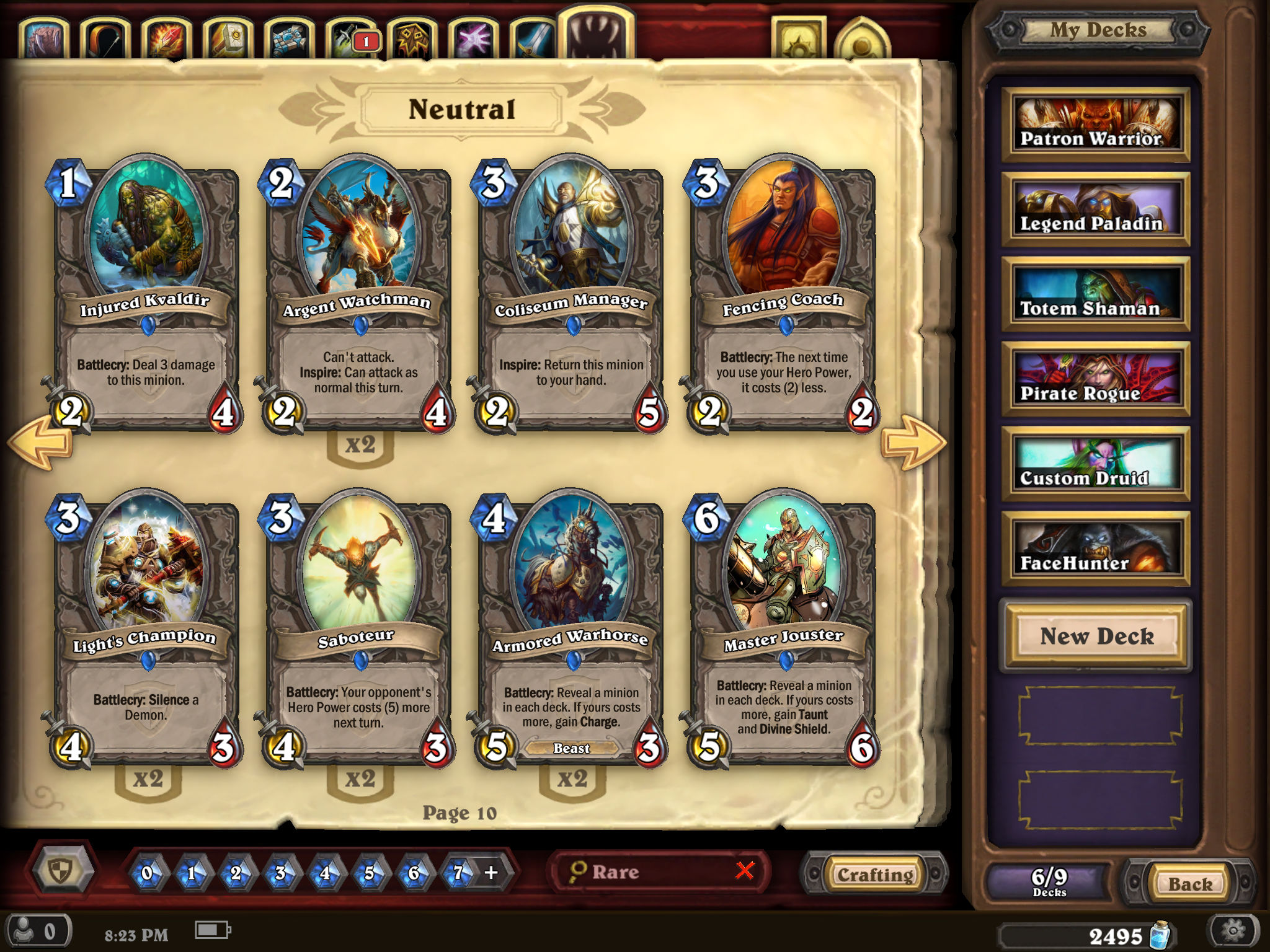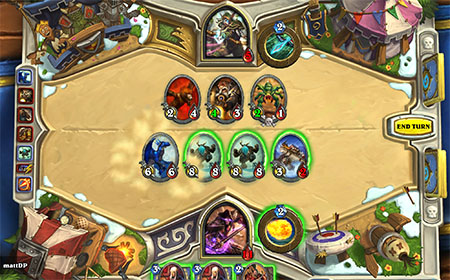Hearthstone - the beginner's guide
Because everyone should play Hearthstone

Hearthstone is a brilliant game. The huge income it makes for Blizzard and the rave reviews it earned are testament to that. As a result, it's had four expansions so far.
That's great for regular players. But if you've haven't partaken of this flavour of Kool-Aid yet, it's off-putting.
There are plenty of guides on how to get started, but they date back to the game's release. And after those expansions, it's not the same game any more.
We think everyone should have the chance to sample this excellent card game, so we've put together this catch-up guide.
It'll rattle through the basics with pointers on where to find more. Then we'll get to the good stuff - what you need to grab to get competitive as fast as possible.
Setting outAlthough Hearthstone is a collectible card game, there are lots of cards you can get for nothing. These are known as Basic cards. You get access to all the neutral ones - those that any class can use - as soon as you finish the tutorial.
Once you've done that, your next task is to get access to all the class-specific Basic cards. To do this you need to build a deck for a class and play it, earning experience. As you do, the class will level up for you, unlocking the basic cards one by one.

Fortunately you can build effective decks for every class with access to just the Basic cards. Suggesting builds is beyond the scope of this article.
Just search for "Hearthstone basic decks" and you'll get plenty of options. If you lack access to a card in one of these builds, just replace it with another of a similar cost until you get it.
Once you've built a deck, start out in Practice mode. Here you can unlock each class by playing against an AI-controlled deck for that hero. Once you've unlocked all the heroes, repeat the exercise in Expert mode for a 100 gold bonus.
DustingAfter that, it's time to head out into the big bad world of Play mode against other humans. You'll earn extra experience that way to get the rest of the Basic cards.
Plus in Play mode you can beat the quests the game gives you to earn gold. Gold is what you need to buy card packs and access to solo play adventures.
To start with, you want to focus on classic packs. These are the ones around at the original release of the game, and they still contain the majority of the most-used cards.
That's especially true of the Epic and Legendary cards that are hardest to come by.

It won't be long before your collection starts to have more copies of particular cards than the two you're allowed in the deck.
Once it does, the little blue "crafting" button will start flashing at you. You can press it to turn your excess cards into Dust.
Dust is great. You can spend it on constructing new cards that you actually need.
One of the top targets is Dr. Boom. Some people think he's overpowered and due a nerf, but don't worry. His utility is more down to the fact that he's useful in almost any deck style and any class. He costs a hefty 1600 dust though, so you'll need to start saving up.
In the meantime, you'll probably have found that there are two or three classes that suit your play style more than others. Your next step is to use that dust to craft the most useful non-classic cards for those classes so you can build better decks.
Classy playThe next big question is - what are those cards? Well, that answer obviously depends to some extent on what decks you're thinking of playing. But here's our class-by-class suggestions of what to grab first.
Druids are still best relying on their classic range of cards. There are a couple from the most recent Grand Tournament expansion that are worth crafting, though. They are Darnassus Aspirant and Living Roots.
Same goes for Hunter. The Goblins vs Gnomes card Glaivezooka should be high on the agenda, though, especially if you're playing an aggressive deck.
For Warriors, Shieldmaiden is a great way of putting a minion down while adding to your armour tally. Alexstrasza's Champion is also a good add if you want to play with dragons.

Rogues have seen more significant shifts in their card line-up. The Goblin Auto-Barber and Tinker's Sharpsword Oil from Goblins vs Gnomes are pretty essential.
You can play an old-fashioned Warlock zoo or Handlock with classic cards. But if you want to try something more mid-range with this class you'll need to do some crafting.
Imp-losion is now a common class fixture, and Mistress of Pain can also be useful. Fist of Jarraxus doesn't look a great card on paper, but it can be devastating in the right deck.
It's a similar story for the Shaman. To be competitive you're going to need Totem Golem and Tuskarr Totemic. The weapon Powermace also opens up workable mech decks for the class.
Speaking of mech decks, you'll need to build a bunch of cards for the classic mech Mage. In addition to the mechs themselves, you'll want Goblin Blastmage. Unstable Portal is a key part of spell-based decks.
Paladins can get expensive. That's because they've got the powerful epic cards Coghammer, Mysterious Challenger, and Quartermaster. At the cheaper end of the spectrum Muster for Battle, Tuskarr Jouster, and Murloc Knight are all quality picks.
Finally, Priests can also be pricey. The epic Lightbomb has a spot in a lot of decks. Before that, consider crafting Shrinkmeister, Velen's Chosen, Wyrmrest Agent, and Holy Champion.
Growing wingsIf you've had as much fun with Hearthstone as we have, you might think it's only fair to spend some real money on it. After all, Blizzard can't keep running servers or paying devs without it.
You can do that by purchasing cards packs if you like. A better way for most players, however, is to spend it on unlocking solo adventures.
There are two of these: Curse of Naxxramas and Blackrock Mountain. Neither is particularly compelling to play through for its own sake.
But as you beat the AI opponents in each, you unlock cards to add to your collection. Solitaire play in these adventures is the only way to get those cards, and some are extremely useful.
It's worth buying these with real money because, compared to the cost of card packs, it's much better value to use real coins than in-game gold.
Each adventure consists of several "wings", each of which has its own cards. Not all wings are equally worthwhile, though. Some have much better cards than others.

A good place to start is with the Blackrock Depths wing of Blackrock Mountain. It's got an incredible selection of cards. Emperor Thaurissan is one of the more powerful legendaries in the game, and can find a spot in almost any deck.
Grim Patron is the power behind Patron Warrior, widely reckoned as the best deck archetype in the game. The Hunter and Mage cards Quick Shot and Dragon's Breath are also very useful if you play either class.
None of the other wings in Blackrock are really essential. Although you could consider buying access to the Hidden Laboratory if you ever want to run a dragon deck.
Curse of Naxxramas, by contrast, has several useful wings for possible purchase.
The most useful one is probably The Plague Quarter. Sludge Belcher is the best card here, a perennial fixture in mid-range and control decks to help save your face and other minions from damage.
However, Loatheb can be powerful once you know how to use him and Unstable Ghoul has a place in several deck types. The class cards are again for Hunter and Mage and both see regular use in those classes.
Your other picks are a bit more class dependent. The Arachnid Quarter has Haunted Creeper and Nerubian Egg which are good in aggressive decks.
Undertaker, Mad Scientist, and Zombie Chow from The Construct Quarter also work in aggro decks. Plus the Priest and Warrior class cards there are very handy.
